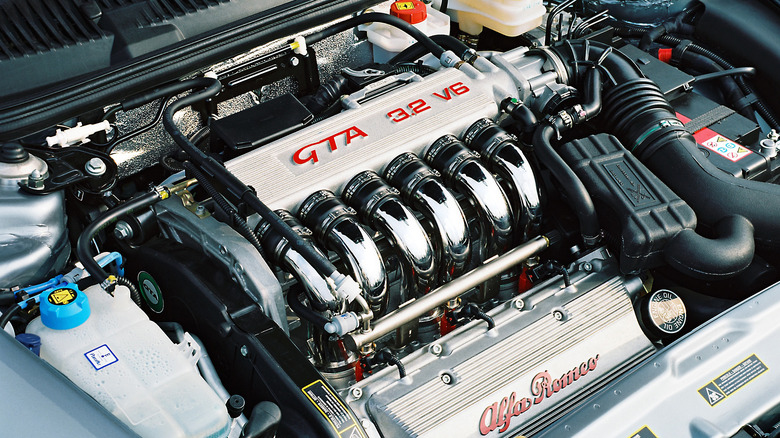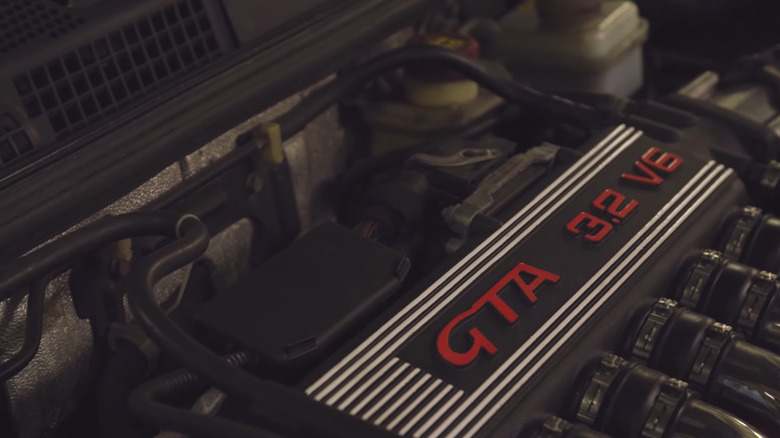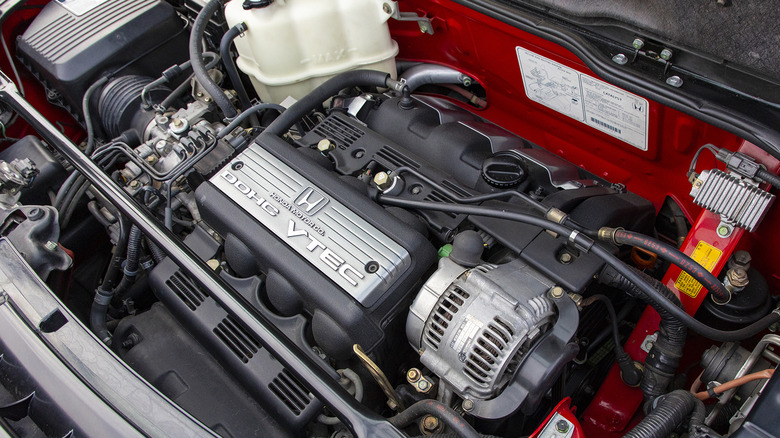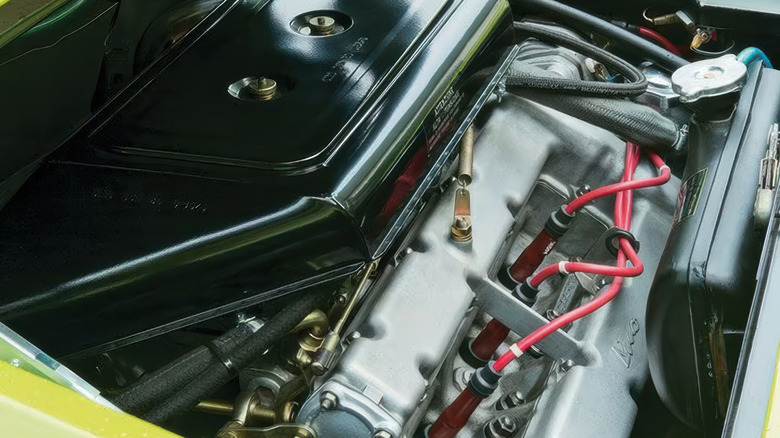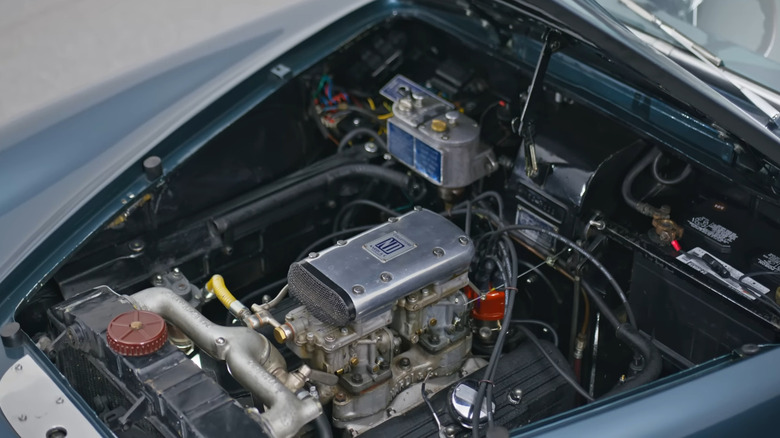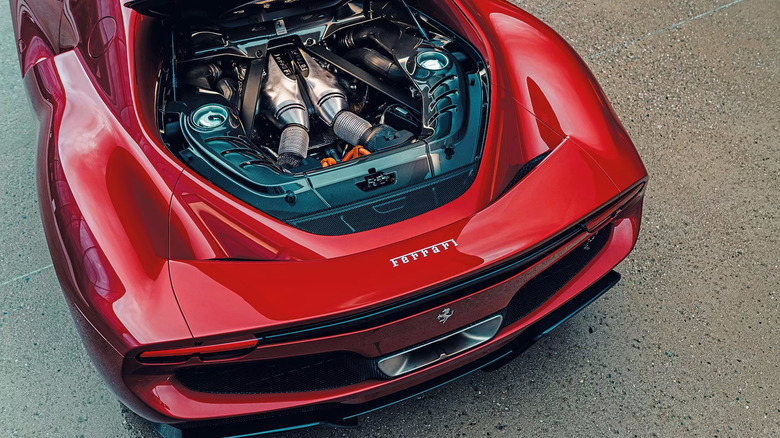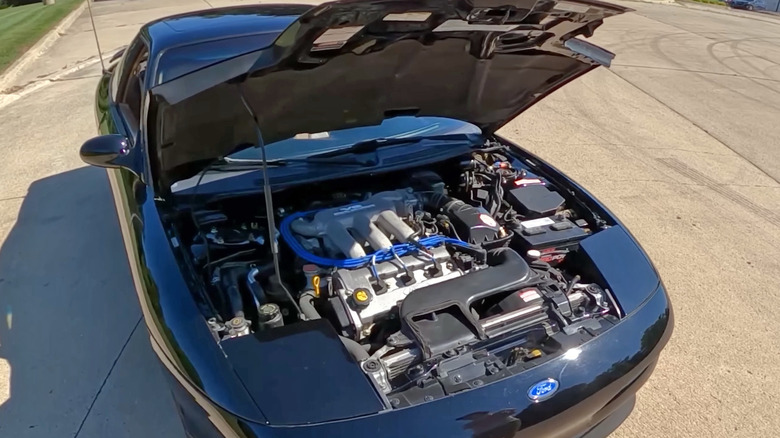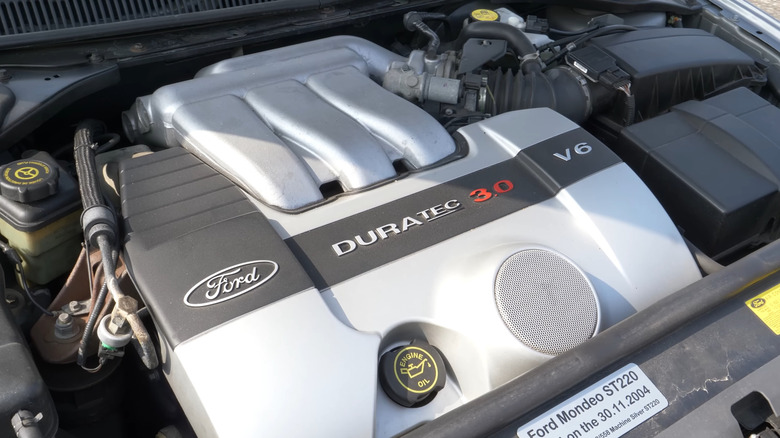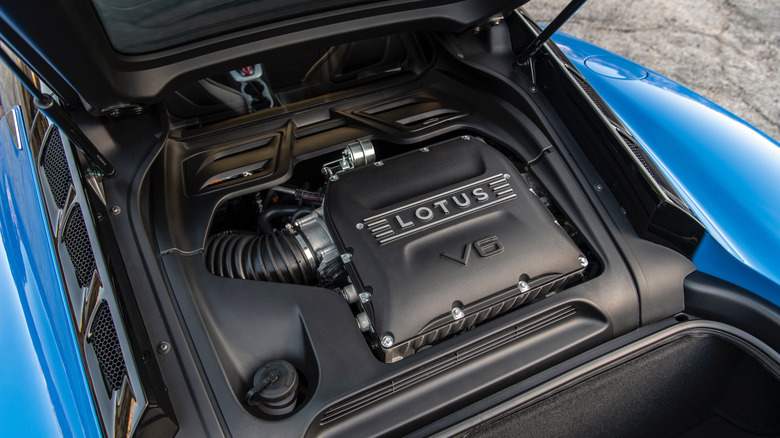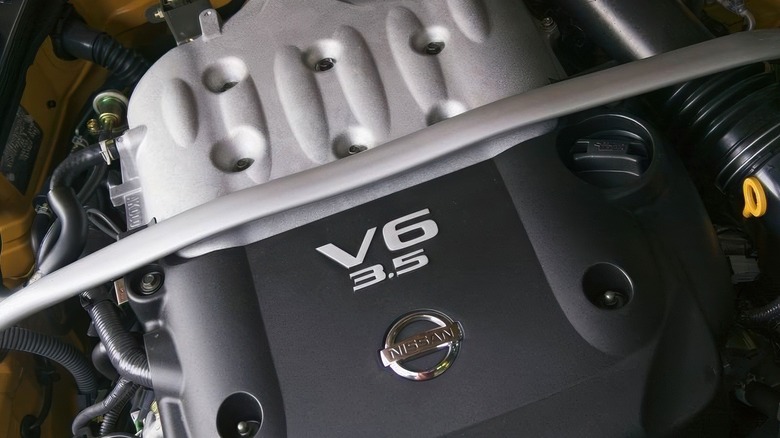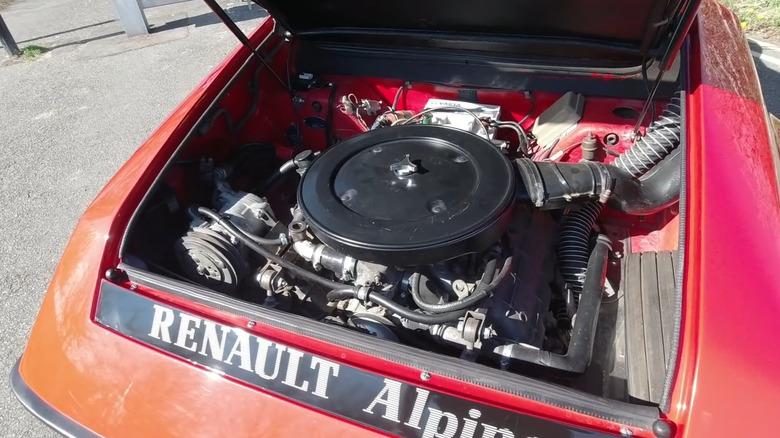12 Of The Best-Sounding V6 Engines Ever Made
Often rejected by enthusiasts for its complexity and lack of inherent balance, the V6 engine never reached the spotlight of the inline-six or V8 layouts. Yet, in today's era, when most manufacturers go the turbocharged four-cylinder route, a V6 seems like a much more desirable option. It's smoother, more refined, and feels way less stressed during acceleration. Thanks to its compact design, the V6 is also incredibly versatile. You can put one in pretty much any vehicle, which can't be said for an inline-six.
In the right application, a V6 can sound glorious, too. Sure, better sounding inline-six, V8, V10, and V12 engines are more plentiful, but in this piece, we'll prove that V6 engines can definitely provide an auditory spectacle. Harmonious and refined, yet angry and raspy enough. Not only that, but most of the engines listed here are quite potent, too, giving some modern supercars mighty acceleration off the line. So, from Italian classics to French rarities, here are some of the best-sounding V6 engines ever made.
Alfa Romeo Busso V6 (1980-2005)
Ask experts about the best-ever V6 engine, and chances are, you'll hear the word "Busso" right away. Designed by legendary automotive engineer Guiseppe Busso, it's undoubtedly Alfa Romeo's most important engine, serving many of its vehicles for decades.
Thanks to the 60-degree angle between the cylinder banks, the Busso engine was compact, making it easy to fit in most Alfa Romeo vehicles. That layout also reduced thermal losses and allowed for straighter inlet tracts, crucial for the engine to breathe better. Busso showed his engineering brilliance in other areas; the famous V6 also has no balancing shafts yet operates smoothly thanks to an offset weight crank pulley.
The first Busso V6 units ranged from 2.0 liters to 3.0 liters in capacity and two valves per cylinder. Still, it's the 24-valve units, introduced in 1992, that brought power and efficiency to another level. The latest 3.2-liter unit made 240 hp and 221 lb-ft of torque, giving the stunning 147 GTA hot hatch some serious oomph.
For all its performance, though, the noise is what made the Alfa Romeo Busso V6 special. This is not only one of the best-sounding V6 engines ever made, but engines, period. The Busso V6 reveals its character right after you turn the ignition key. Deep and throaty at idle, it builds up with intensity as the revs go up, reaching a glorious, racecar-like crescendo. At higher revolutions, the Busso V6 becomes an animal, with a raw, yet smooth, organic roar. It's an engine you'll want to rev repeatedly just to experience the sonic extravaganza it produces.
Honda/Acura NSX 3.0 V6 (1991-2005)
Lightweight, balanced chassis. Short, mechanical, and tactile five-speed manual. A smooth, high-revving V6 with sound to die for. It's safe to say that Honda (Acura in North America) nailed the mid-engine supercar formula right from the beginning. Designed to compete with Ferrari and Lamborghini, but with a Japanese twist, the first-gen NSX became an instant icon. The original NSX remains highly sought-after today, with prices easily reaching six figures.
Honda's first supercar was also a technological tour-de-force. With a design inspired by the F16 fighter jet, its monocoque was made almost entirely from aluminum for weight reduction, with Honda developing a special spot-welding machine to produce it.
Then there's that stunner of an engine. The 3.0-liter V6 also had a block made from aluminum, DOHC, and 24 valves. Crucially, Honda used VTEC, allowing the V6 to breathe better at higher revolutions, with an exhilarating 8,000-rpm redline. Oh, and with 270 hp and 220 lb-ft of torque on tap, it propelled the NSX to 60 in just 5.2 seconds.
Those seconds are some of the most enjoyable you'll find in the industry, thanks to the sonorous nature of the C30A engine. Honda's take on the V6 sounds refined and silky, revealing unmatched engineering precision. As you press the throttle pedal, the buildup is smooth and linear, accompanied by a crisp intake noise. Once the VTEC kicks in, though, it hits you like an ecstasy, with a spectacular high-pitched scream.
Ferrari Dino V6 (1967-1974)
The Dino was Ferrari's first mainstream effort, designed to bring younger buyers to its showrooms. Compact and lightweight, with a mid-engine configuration, the Dino was built for twisty roads, rather than the racetrack. And with a 2.0-liter V6 engine, the first Dino 206GT wasn't your typical V12-powered Ferrari.
The car remains one of the most enjoyable road cars Ferrari has ever produced. A big part of the experience is the V6 itself, which sounds as glorious as the prancing horse's V12 supercars from the past. It's the closest you'll get to a race car with this kind of engine — hardly surprising, as it first appeared in an F2 open-wheel racecar. Raw, raspy, yet defined and mechanical, the Dino's V6 is a feast for the senses. As you approach the redline, it turns into an intoxicating melody. Of course, the five-speed gated manual, one of the best transmissions in automotive history, added to the experience with its tactile, mechanical action.
This V6 also has the performance numbers to back up its incredible sound. The 2.0-liter unit in the original made 180 hp, an astonishing figure for the era. Meanwhile, the upgraded 246GT received a 2.4-liter unit, capable of 195 hp. Crucially, it made way more torque at 165 lb-ft vs. 137 lb-ft. Thanks to the low curb weight of 2,615 pounds, the Dino sprinted to 62 mph in brisk 7.1 seconds.
Volkswagen VR6 (1991 to 2024)
It's an inline-six! It's a V6! Call Volkswagen's VR6 any way you like, and it won't change the fact that it's one of the best six-cylinder engines in history. Sure, the VR6 is not a pure V6, but its configuration nevertheless resembles the letter "V," albeit a very tight one. Volkswagen calls it a V-Reihenmotor-6 (V-inline-six), but with a 15-degree cylinder bank angle, we think it belongs on this list.
Okay, but why the VR6 configuration? Well, it's all about keeping things compact. It was as small as a four-cylinder, meaning VW could use it in front-wheel-drive compact cars like the Corrado, one of the seven cars equipped with a VR6 engine. The VR6 configuration was also more balanced than inline-four, resulting in smoother, more refined operation.
The first VR6 engines had 2.8-liter and 2.9-liter capacities, depending on the market, with power ranging from 140 hp to 188 hp. Still, larger versions soon arrived, with the B6 Passat R36 packing a 3.6-liter unit with 295 hp. Volkswagen continued to use the VR6 until 2024, when the 3.6-liter unit in the Atlas SUV was replaced with a 2.0-liter turbocharged four-cylinder.
That change irked some VW purists, mainly because of VR6's distinctive sound. With a deeper, throaty noise at lower revolutions, and a raspy, yet harmonic intake note at higher rpm, the VR6 is one of the most characterful six-cylinder engines ever made.
Lancia Aurelia V6 (1950-1958)
There is no way we would've left the Lancia Aurelia out of this list. It's the first-ever car with a V6 engine, after all, but it's also significant in other aspects. The B20 GT version, for instance, was the first-ever modern grand tourer. The B24 Spider was one of the best-looking cars designed by Pininfarina. Aurelia's platform was also very advanced for the era, independent suspension on both ends and an excellent weight distribution, thanks to the transaxle layout. Regardless of the body style, the Aurelia looks timeless, yet way more modern than other cars from the 1950s.
Still, it's the V6 implementation that stood the test of time. Lancia went with a 60-degree angle for the optimal balance and made both the head and block from aluminum. Initially, the engine had a 1.8-liter capacity, but by the end of the production run, Lancia upgraded it to a 2.5-liter unit with 118 hp. It was enough for a top speed of 115 mph (B24 2500 GT), an impressive feat for the era.
However, perhaps the most impressive quality of Lancia's early V6 engines is their sonic signature. They sound effortless and free breathing at low to medium revolutions, yet raspy and mechanic at higher revolutions. Of course, due to the worse sound insulation compared to a modern car, you'll hear more of the valvetrain chatter, but that only adds to the experience.
Ferrari 296 GTB 3.0 Twin Turbo V6 Hybrid (2021-Present)
Most people would say turbocharged engines can never sound as good as their naturally aspirated counterparts. Sure, they can add a significant amount of power, but they also muffle the intake and exhaust noises. Yet when you hear the Ferrari 296 GTB singing while approaching the redline, you'll certainly question that argument, especially since it's also a hybrid.
Yes, the high-revving V8 in the 458 sounds better. But you can't deny that Ferrari did a damn good job with the 120-degree, 3.0-liter twin-turbo V6 in the 296 GTB. You still get the captivating sonic signature Ferrari is known for. Exhilarating. Ferocious. Rich, yet still razor-sharp at higher revolutions. It's a bit muffled compared to the 458's V8 zinger, but still incredibly satisfying for a twin-turbo V6.
The Ferrari V6 symphony is all the more impressive when you also add the numbers to the equation. On its own, the twin-turbo unit makes impressive 654 hp and 546 lb-ft of torque. Amplified by a 165-hp electric, the advanced powertrain makes 819 hp, all going to the rear wheels via an eight-speed dual-clutch gearbox. As you'd expect, the 296 GTB is a missile in a straight line, reaching 60 in a mind-boggling 2.4 seconds. The 205-mph top speed is pretty nuts, too. Oh, and as you'd expect from a mid-engine Ferrari, the 296 GTB is also very good around corners.
Ford GT 3.5 EcoBoost V6 (2016-2022)
The V8 engine has deep roots in Ford's racing and performance car history. From the Mustang to the GT40, there is a thumping V8 singing its throaty song. So, when Ford introduced the GT supercar, everyone was surprised to learn that it had a twin-turbo V6 engine in the middle.
Still, if a V6 is good enough for Ferrari, it must be good enough for a Ford. And make no mistake, the beautiful Ford GT has enough brute force to snap your neck during acceleration. 647 hp and 550 lb-ft of torque, a relatively low curb weight of 3,381 pounds — thanks to the carbon fiber construction — and a lightning-quick seven-speed dual-clutch auto all combine to sprint to 60 in 3 seconds flat. Oh, and thanks to the advanced, racecar-like aerodynamics, the Ford GT has an astonishing top speed of 216 mph.
The 3.5-liter EcoBoost V6 sounds good, too. It won't sound as angry as a Ford V8, but due to the GT's limited sound insulation, the V6 fills the cabin with all the right noises. It's deep and controlled at lower revs, with just the right amount of howl as the tachometer needle reaches the redline. The hiss of the turbochargers adds to the sonic experience, reminding you of the engine's hunger for air as it unleashes its full potential.
Mazda MX-6/Ford Probe GT 2.5 V6 (1992-1997)
You don't need to spend a fortune to enjoy a smooth V6 symphony. The second-gen Mazda MX-6 and Ford Probe GT twins might not have offered supercar performance, but they were super cheap and still pleasurable to drive. A big part of the experience is of course Mazda's 2.5-liter naturally aspirated V6 unit powering the front wheels. Interestingly, the engine is a bored and stroked version of the 1.8-liter V6 unit in the MX-3, though it replaced the 145-hp, 2.2-liter turbocharged four-cylinder from the previous-gen vehicles. In the second-gen models, a 2.2-liter naturally aspirated four-cylinder was the entry-level engine.
With 164 hp and 160 lb-ft of torque on tap, the V6 was quite potent for the era, sending the Probe GT to 60 mph in just 7 seconds. Both cars came with a five-speed manual as standard, sending the power to the front wheels only. So no drifting was possible, but as far as sonic experiences go, it didn't get much better than these. Mazda's V6 sounds smooth and free breathing, with a raspiness in the background reminding you of its cylinder configuration. It's not loud or raucous, but it still has a performance edge to it. You'll undoubtedly push it close to 7,000-rpm redline quite often.
Ford Mondeo ST220 3.0 Duratec V6 (2001-2007)
Ford also had its own sonorous 1990s V6. Called the Duratec, this 60-degree 3.0-liter unit was meant to replace the aging 3.8-liter V6 in the automaker's lineup. It was quite an advanced engine for the era, with DOHC, four valves per cylinder, sequential multipoint injection, and cast-iron cylinder liners. Ford used it in the Taurus and Mercury Sable, though the Duratec V6 was later utilized in the Jaguar S-Type, Lincoln LS, Mazda 6, and Mondeo ST220 (in Europe). A version with variable valve timing appeared in 2006, propelling the Ford Fusion, Mercury Milan, and Lincoln Zephyr.
The Duratec V6 was quite a potent engine, producing 224 hp and 203 lb-ft of torque in the Mondeo ST220. 0-60 took only 6.8 seconds, an impressive feat for a front-wheel-drive sedan with a six-speed manual. Still, accelerating in the Mondeo ST220 was all about the noise; the Duratec V6 sounds throaty at lower revolutions, with a linear buildup as it approaches the 6,800-rpm redline. There is a hint of motorsport in the sonic signature that gets your heart pumping faster. It's raspy and angry yet still refined. The fact that you get to experience it with a stick shift only adds to its appeal.
Lotus Emira Toyota-Sourced 3.5 Supercharged V6 (2023-present)
The Lotus Emira looks like a junior super car. It's dramatic, exotic, perfectly proportioned, and easily one of the most exciting sports cars to come out this decade. Instead of chasing horsepower figures, it focuses on what's important in a sports car — the experience.
As with all mid-engine Lotus fun machines, the Emira is all about attacking twisty roads. The hydraulic steering is perfectly weighted and precise, while providing you with all the information you need from the road. The Emira also corners without body roll, and has incredible chassis balance. It communicates even the slightest loss of traction, too.
Regardless of the engine you choose, it's also quick in a straight line. The 400-hp 2.0-liter AMG-sourced turbo four-cylinder reaches 60 mph in 3.8 seconds. However, it sounds a bit tame and only comes with a dual-clutch gearbox. For purists, the 400-hp Toyota-sourced 3.5-liter supercharged V6 might be a better option, as it comes with a six-speed manual. The shifting stick isn't the last call in precision, but it will keep you engaged. With a 4.2-second sprint to 60, the V6 also isn't much slower.
Crucially, the supercharged V6 sounds way more interesting. It's a bit mediocre at lower revolutions, but once you spool it up, the V6 reveals its performance credentials. Past 3,000 rpm, the Toyota engine produces a properly loud, mechanical, high-pitched noise that will surely give you goosebumps.
Nissan 350Z 3.5 V6 (2002-2009)
Nissan's Z lineage of sports cars is one of the longest standing in automotive history, rivaled only by legends like the Porsche 911, Ford Mustang, and Chevy Corvette. So, after a five-year hiatus (1997 to 2002), Nissan had big shoes to fill with the 350Z. The Japanese automaker opted for a front-to-mid engine configuration, and a naturally aspirated V6 engine. The lack of a turbocharger didn't hurt the new model one bit. The Nissan 350Z's 3.5-liter V6 engine ended up being quite good, producing 306 hp after its 2007 upgrade. Crucially, it came standard with a six-speed manual, with a lower-powered five-speed auto being available as an option.
The manual had another trick up its sleeve — it revved to smile-inducing 7,500 rpm, compared to 6,600 rpm in the auto. Revving it out not only gave some serious shove in the back (0-60 mph in 5.4 seconds), but also provided a sonic spectacle. It might only be a V6, but the VQ35HR unit sounds like an engine with at least two more cylinders. Throaty and deep at idle revs. Satisfyingly deep and rumbly at medium revs. Near the redline, it has that raspy and angry character we all want in sports cars. It growls energetically. The fact you could get this experience in an entry-level sports car is quite astonishing, really.
Alpine A310 Renault 2.7 PRV V6 (1976-1985)
Classic French sports cars are relatively unknown in North America. That's a shame, as France gave us many gems over the years. Case in point, the Alpine A310, one of the coolest-looking sports cars you never knew existed. It looks cutting-edge and futuristic, but also angry and muscular, almost like a predator.
The A310 was cutting-edge in other areas as well. Its body consisted of fiberglass panels and a tubular spaceframe chassis, resulting in a shockingly low curb weight of 2,183 pounds. Intriguingly, Alpine went with a rear-engine, rear-wheel-drive layout, just like a Porsche 911. Initially, the engine was an underpowered four-cylinder (125 hp).
Fortunately, in 1976, Alpine improved the A310 dramatically with a larger 2.7-liter PRV V6, developed as a joint venture by its parent company Renault, Peugeot, and Volvo. The V6 made 148 hp and 161 lb-ft of torque and came exclusively with a five-speed manual. Thanks to the featherlight chassis, it was enough for a 0-62 mph sprint of 7.8 seconds and a top speed of 140 mph.
It sounds glorious, too. Raw, unrefined, and raspy. The sonic signature may lack the precision of an Alfa Romeo Busso V6 but still has a linear progression as you rev it out. Crucially, it suits the A310's character perfectly. This is a lightweight sports car, after all, designed for pure driving enjoyment.
